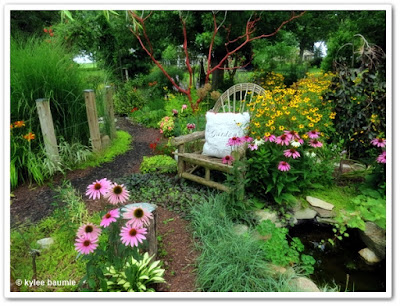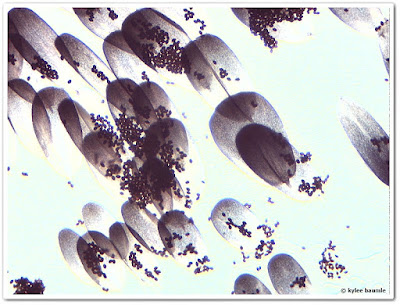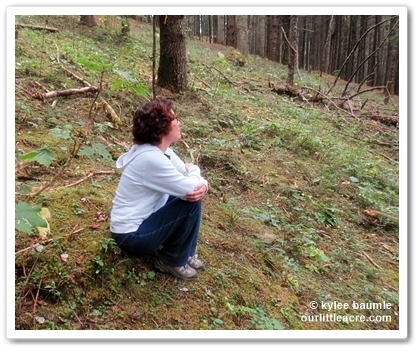We didn't do maple syrup last year because Romie and I both went to Mexico to see the monarch butterflies as they overwintered there. That trip hit right smack in the middle of sap collecting, so we decided to just not do it. Oh, how we missed that wonderful homemade maple syrup!
I went to Mexico again this year, once again in the middle of sap collecting, but Romie was home, so he gathered it while I climbed a few mountains. I have to thank our daughter, Kara, for her help after I got home, because after one day to recover and repack, Romie and I both went to Florida for a week to visit my aunt and uncle. It truly takes a family to make this stuff.
This year, though we didn't keep track of how many gallons of sap we collected from our silver maple trees, we ended up with about three quarts of syrup. We would have had a little bit more (maybe a cup or so), had I not burned one small batch to a crisp. I blame Romie for this a teeny tiny bit, because we only had a small amount of sap, and he talked me into boiling it against my better judgement.
When you boil sap, it's always better to do a large batch at one time, because when it gets right down to the last few minutes of boiling, the sap can either turn to sugar or burn. Just. Like. That. With a larger batch, you have more play with it. I'm not sure why that is, but it just is. I didn't forget it, I just needed to check it in a few minutes rather than ten. Lesson learned!
This year, I used a hydrometer part of the time, for testing when the sap was of the right consistency for syrup. You pour the sap into a cylinder and then float the hydrometer in it. It's marked with red lines, and you want your sap to be thick enough for the surface of the sap to fall between the red lines. After a few seasons of doing this, I think it's just as easy to eyeball it.
Every year I make this, there are always a few who say to me, "Please keep some back for me." I cringe when I hear that, because there's no way we could do that for everyone who asks. We can't even do it for a few, since it takes about 40 gallons of sap to make a gallon of syrup. With that ratio, you can see how much sap it takes to make a small amount and just how time consuming making syrup is. There's a reason it costs so much when you buy it in the store.
I'm kind of like fellow blogger Karen Bertelsen (
The Art of Doing Stuff) when it comes to this. When someone asks her for some of her maple syrup when she's done making it, she answers, "Sure!" and then promptly forgets. She does put a couple of small bottles back just in case she needs to reward someone for doing her an extraordinary favor. And I'm not entirely selfish. A few of our bottles make their way to new homes, too.
 |
This year I splurged and purchased special bottles for our maple syrup.
You can buy them here. |
Back to this year's syrup making. The season always takes me by surprise. It starts just about the time I've had it with winter and am dreaming of crocus and daffodils and spring peepers. But I don't think I've ever gotten the spiles put into the maples early enough to get absolutely all the sap we could get.
 |
| When the maple buds look like this, maple syrup is drawing to a close. |
The sap starts running towards the end of winter, when the temperatures are below freezing at night and above freezing during the day. There are a lot of days like that between the end of January and when the maple trees start budding out. That's when the sap stops flowing, or at least stops being clear (instead of cloudy or dark). This year, we began collecting sap on February 9th and collected the last of it on March 21st.
A taste test
I haven't purchased real maple syrup since we started making our own, but this year, I heard about a brand that has gotten rave reviews and came to light as a result of being on
Shark Tank.
Parker's Maple Syrup didn't get the deal on the show, but it still helped the company just by being on the show. I bought some because I wanted to see how ours tasted in comparison.
The tin of Parker's arrived last week and when I tasted it, I sort of cringed. It wasn't cheap and I didn't like it. I bought the Grade A Robust, which is essentially the same grade as ours. But ours had a pure and strong maple syrup taste,
without the smoky, somewhat burnt taste to it. Parker's had somewhat the same taste as
Kirkland brand maple syrup I purchased from Costco a few years ago. I just don't like that scorched taste.
 |
| Our maple syrup is on the left. |
I may have mentioned before that I'm a
supertaster. This means, among other things, that I detect bitterness more than the average person. My tastebuds have receptors that many people's don't. My husband didn't think it tasted burnt at all. Okay, good, honey. You can have the Parker's then, and I'll just stick with ours, if you don't mind.
We also did a taste test with maple syrup made by the brother of our son-in-law. The semi-blind taste test involved five different syrups: Mrs. Butterworth's Syrup (not real maple syrup), ours, the brother's, a local commercial producer's, and Parker's. Seven people tasted the five syrups and the results were incredibly varied. Three of the seven preferred our syrup over the others, and more than half rated Parker's the worst, even worse than Mrs. Butterworth's.
Do you have a favorite maple syrup brand? I've not found any that I like as much as ours. ❤
















































